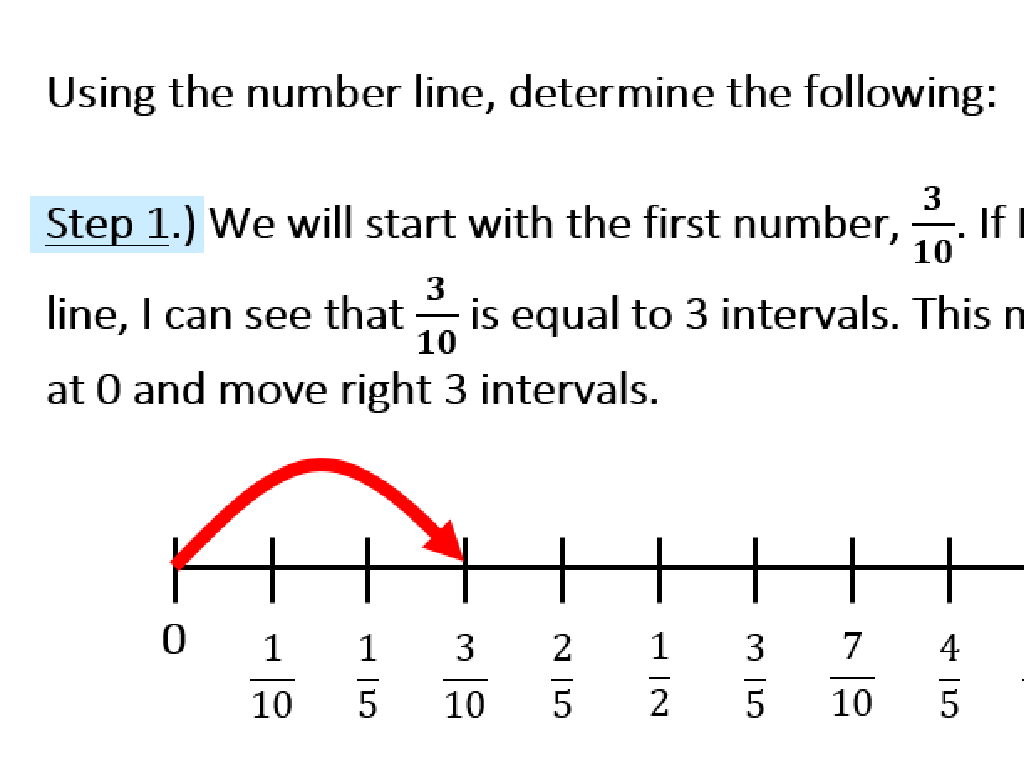Compare Sums And Differences Of Decimals
Subject: Math
Grade: Fifth grade
Topic: Add And Subtract Decimals
Please LOG IN to download the presentation. Access is available to registered users only.
View More Content
Today’s Adventure: Comparing Sums and Differences of Decimals!
– Quick review of decimals
– Decimals represent fractions of a whole, like money.
– Comparing decimal sums
– Add decimals and compare results, e.g., 0.75 + 0.25 vs. 0.50 + 0.50.
– Comparing decimal differences
– Subtract and compare, e.g., 1.00 – 0.25 vs. 1.00 – 0.75.
– Relevance of decimals in daily life
– Use decimals for money, measurements, and more.
|
Begin with a brief review of what decimals are and how they represent parts of a whole, using money as a relatable example. Move on to comparing sums of decimals by adding different pairs of decimals and seeing which sum is greater. Do the same for differences by subtracting decimals. Emphasize the importance of understanding decimals in everyday life, such as when dealing with money, cooking measurements, and comparing quantities. Encourage students to think of other daily situations where they use decimals. This will help them understand why it’s important to learn how to compare decimal sums and differences.
Review of Adding Decimals
– Recall adding decimals process
– Align decimal points vertically
– Ensure each number’s decimal is one under the other
– Add like whole numbers
– Ignore the decimals and add the numbers as if they’re whole
– Decimal point in answer aligns
– The answer’s decimal must be in line with the numbers’ decimals
|
This slide is a refresher on the process of adding decimals, which is a foundational skill for comparing sums and differences of decimals. Emphasize the importance of aligning the decimal points, as this is crucial for accurate addition. Compare it to stacking coins of the same size – they need to be directly on top of each other to count them correctly. After adding, the decimal point in the sum must be placed directly below the others to maintain the value of each digit. Use examples like money transactions, where precision is key, to illustrate the importance of correct decimal placement. Encourage students to practice with different decimal lengths and to check their work by estimating the sum before adding.
Mastering Decimal Subtraction
– Subtracting decimals is simple
– Align decimal points first
– Ensure decimals are vertically aligned
– Subtract like whole numbers
– Ignore the decimals and subtract as if they’re whole numbers
– Decimal point in answer is key
– Place the decimal point directly below the others in the result
|
This slide is a quick review of how to subtract decimals, aimed at reinforcing the students’ understanding and confidence in performing decimal subtractions. Emphasize the importance of lining up the decimal points as the first step, which is crucial for maintaining the correct place value. Remind students to subtract as if they are dealing with whole numbers, ignoring the decimal point during the subtraction process. Finally, stress the importance of bringing down the decimal point into the answer to maintain the correct value. Provide several examples on the board and encourage students to solve them, ensuring they follow these steps. This will prepare them for more complex problems involving decimal subtraction.
Comparing Decimal Sums
– How to compare decimal sums?
– Example: 3.45 + 2.7 vs. 3.4 + 2.75
– Which sum is larger: 6.15 or 6.15?
– Add decimals in each example
– 3.45 + 2.7 = 6.15 and 3.4 + 2.75 = 6.15
– Determine the greater sum
– Compare sums: 6.15 is equal to 6.15
|
This slide introduces students to the concept of comparing the sums of decimal numbers. Start by explaining how to determine which sum is greater by adding the decimals together. Use the example provided to show students step-by-step how to add each set of decimals. Once they have the sums, guide them to compare the results and determine which is greater or if they are equal. Emphasize the importance of aligning decimal points and the role of place value in adding decimals. Encourage students to practice with additional examples and to explain their thinking process when comparing sums.
Comparing Decimal Differences
– Comparing two decimal differences
– Example: 6.5 – 4.2 vs. 6.5 – 4.19
– Which subtraction gives a smaller result?
– Perform subtraction to find differences
– 6.5 – 4.2 = 2.3 and 6.5 – 4.19 = 2.31
– Determine the smaller result
– 2.3 is less than 2.31, so 6.5 – 4.2 is smaller
|
This slide is aimed at teaching students how to compare the differences between two decimal subtractions. Start by presenting the example problem and encourage students to perform the subtraction themselves. Once they have the results, guide them to observe and compare the differences to determine which is smaller. Emphasize the importance of place value and the role it plays in comparing decimals. This exercise will help students understand that even a small change in a decimal can affect the outcome of subtraction. Encourage students to practice with additional examples for mastery.
Comparing Decimals with Number Lines
– Number lines aid in comparison
– Plotting sums and differences
– Mark the sums and differences on the line
– Visual comparison of values
– Easily see which decimal is larger or smaller
– Determining greater or lesser decimals
|
This slide introduces the concept of using number lines as a tool to compare decimal sums and differences. Emphasize to students that number lines are a visual aid that can help them understand the relative size of numbers. Show them how to plot both sums and differences of decimals on a number line and use this to determine which decimal value is greater or lesser. Encourage students to practice by giving them a set of decimal addition and subtraction problems and asking them to represent the results on number lines. This will help them to quickly and accurately compare the values at a glance.
Let’s Practice Together: Decimals
– Class practice problems
– Use number lines and grids
– Visual aids help understand decimal placement
– Explain your reasoning
– Sharing thought process solidifies learning
– Group discussion and help
|
This slide is designed for an interactive class activity focused on comparing sums and differences of decimals. Start by solving a few problems together as a class to demonstrate the process. Introduce number lines and decimal grids as visual aids to help students better grasp the concept of decimal places and how they affect the sum or difference. Encourage students to verbalize their reasoning while solving the problems, as this will help them and their peers understand different approaches to the same problem. Facilitate group discussions and allow students to help each other, fostering a collaborative learning environment. Prepare a set of practice problems of varying difficulty to cater to all students. The goal is to build confidence and proficiency in adding and subtracting decimals.
Class Activity: Decimal Detective
– Become a Decimal Detective!
– Find decimal sum and difference pairs
– Look for hidden decimals in the classroom
– Compare and determine greater or lesser
– Use your detective skills to compare values
– Solve the mystery of decimals
|
In this engaging class activity, students will search the classroom for pairs of decimal sums and differences that you have previously placed around the room. Each student or group of students will need to use their critical thinking skills to compare the values and determine which is greater or lesser. This activity will help reinforce their understanding of adding and subtracting decimals and comparing their values. Provide guidance on how to line up decimal points and ensure the numbers are in the correct place value. Offer hints and encourage teamwork. Possible variations of the activity could include timed challenges, team competitions, or incorporating word problems that lead to the hidden decimals.
Conclusion & Homework: Decimal Detectives
– Super sleuthing with decimals!
– Align decimals before comparing
– Ensure decimal points are vertically aligned
– Homework: Decimal Comparison sheet
– Practice comparing decimals with the worksheet
– Keep practicing, detectives!
|
Well done to all the students for their hard work in understanding how to compare sums and differences of decimals. Remember, the key to comparing decimals is to line up the decimal points to make sure each place value is correctly aligned. For homework, students will reinforce what they’ve learned by completing the Decimal Comparison worksheet. This will involve comparing different decimal numbers and determining which is greater or less. Encourage students to take their time and check their work carefully. In the next class, we’ll review the homework and address any questions or difficulties the students encountered.






